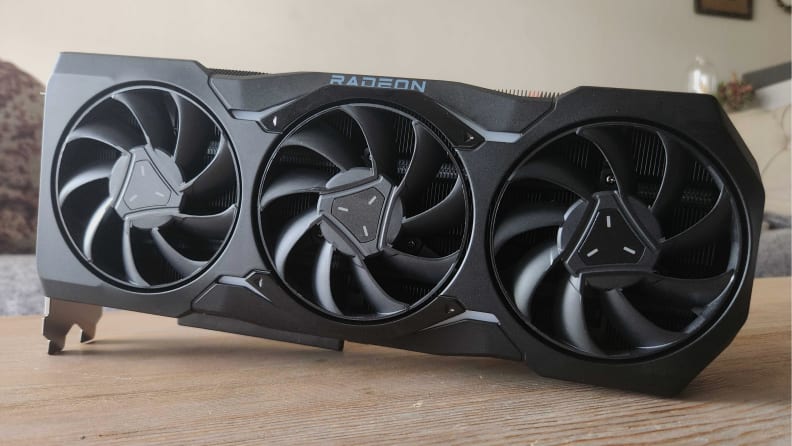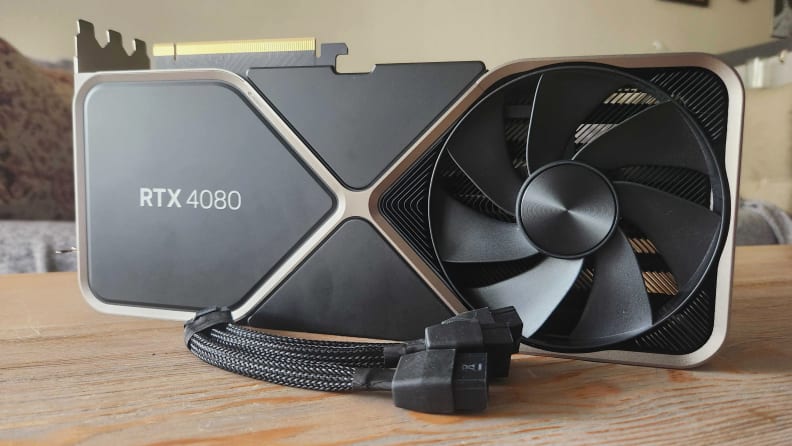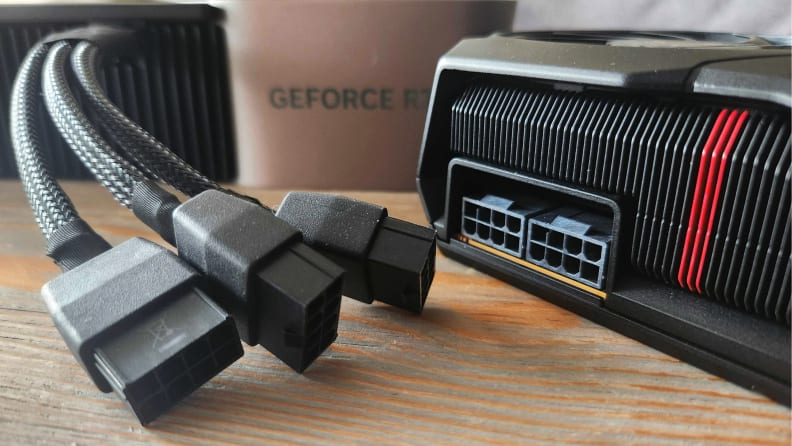The Nvidia GeForce RTX 4080 dropped back in November 2022, with the AMD Radeon RX 7900 XTX following shortly afterward in December 2022. Both graphics cards provide an ultra-detailed 4K gaming experience with stunning performance across the board.
But due to that next-generation performance, both graphics cards are significantly more expensive than their previous-gen counterparts. If you want the performance of the RTX 4080 and Radeon RX 7900 XTX, however, you’re kind of stuck spending a thousand bucks on a single GPU, so you might as well get the best bang for your buck.
Price
Graphics cards are getting way more expensive this generation, with both AMD and Nvidia increasing prices for their new products. There’s nowhere this is more obvious than with the Nvidia RTX 4080 and the AMD Radeon RX 7900 XTX.
Nvidia’s RTX 4080 starts at an eye-watering $1,199, a huge increase over the RTX 3080’s launch price of $699. The AMD Radeon RX 7900 XTX is no different, starting at $999. But that’s just the baseline price for each graphics card. In reality, you’re likely going to be paying a lot more for either graphics card, depending on which version of the GPU you actually buy.
Right now, there’s only one version of the RTX 4080 at the MSRP of $1,199, with other variations of the GPU hitting the $1,500 mark on Newegg. For that money, you might as well go with the more powerful Nvidia RTX 4090.
Nvidia isn’t alone here. The AMD Radeon RX 7900 XTX similarly only has one SKU on Newegg available for $999, with some 7900 XTXs reaching $1,449. But unlike Nvidia, AMD doesn’t have a more powerful graphics card to move up to.
Either way, the AMD Radeon RX 7900 XTX, no matter which version you get, will end up being much more affordable than the RTX 4080.
Our pick: AMD Radeon RX 7900 XTX
Performance

Credit:
Reviewed / Joanna Nelius
While prices are going up in general, the AMD Radeon RX 7900 XTX is still the more affordable choice.
When you’re spending upwards of $1,000 on a graphics card, you want it to be as fast as possible while also spending the least amount of money possible. Even though the price is different between the AMD Radeon RX 7900 XTX and the Nvidia RTX 4080, the performance is closer than you might think.
The two graphics cards trade blows back and forth depending on what game they are running. AMD’s RX 7900 XTX beats Nvidia’s RTX 4080 in games like Far Cry 6 by as much as 13% at 4K, for instance. To be fair, that game is optimized for AMD graphics cards but the RX 7900 XTX can hold its own in games that favor Nvidia’s hardware like Metro Exodus.
The story changes quite a bit when ray tracing is enabled, though. In Cyberpunk 2077 with ray tracing enabled and set to Ultra graphics, the Nvidia RTX 4080 manages a solid 30 frames per second (fps) at 4K, while the Radeon RX 7900 XTX struggles at 20 fps. Whether or not ray tracing performance actually matters is up to you, but if it’s something that interests you, you’re going to be universally better off with the Nvidia GeForce RTX 4080. (Ray tracing on AMD’s Radeon 7000-series cards is about the same as Nvidia’s 30-series cards.)
Both graphics cards do offer upscaling technology that makes workloads like ray tracing more feasible, but the Nvidia GeForce RTX 4080 edges ahead when it comes to raw performance, especially when ray tracing is taken into consideration.
Our pick: Nvidia GeForce RTX 4080
Features and software

Credit:
Reviewed / Joanna Nelius
Razor-sharp graphics are made possible through the RTX 4080’s Deep Learning Super Sampling.
Gone are the days when raw benchmarks and performance were all that mattered for a graphics card. These days, GPUs are sold just as much on their software support as their ability to run the best PC games at the highest settings.
Right now, the most important feature is upscaling. Both Nvidia and AMD have upscaling technology that lets your computer render your game at a lower resolution, then upscale it to your native resolution with AI. This means you can get much better performance out of the games you own (assuming they support upscaling) without sacrificing razor-sharp graphics.
Nvidia does this through Deep Learning Super Sampling (DLSS). This uses the physical Tensor cores found in each modern Nvidia graphics card, then uses machine learning to reconstruct a lower-resolution image to a higher resolution. These days, DLSS is the go-to solution for upscaling and makes ray tracing even more accessible than Nvidia’s ray tracing (RT) cores alone.
AMD uses a more open-ended approach. AMD’s FidelityFX Super Resolution (FSR) has the same goal as DLSS, but rather than using physical cores or hardware-accelerated AI workloads to do it, FSR uses software to upscale the resolution. It’s also open-source rather than proprietary software, which means it’s likely more games will support it in the future, but because it’s a newer technology the list of games isn’t quite as impressive as Nvidia’s currently.
Both graphics card manufacturers also have a wide range of features that enhance gameplay even further. For instance, Nvidia Reflex helps reduce latency in games where response time is everything. (Looking at you, Overwatch 2.)
Nvidia generally has better support for its software features, and with how impressive DLSS is these days, Team Green is the clear winner here.
Our pick: Nvidia GeForce RTX 4080
Compatibility

Credit:
Reviewed / Joanna Nelius
The RTX 4080’s adapter, with its graphics card with four extra cables, is more unwieldy than its competitor’s.
The Nvidia GeForce RTX 4080 and the AMD Radeon RX 7900 XTX are both power-hungry and you’re going to need a high-end machine to even run them.
In my personal testing, the Nvidia GeForce RTX 4080 will suck up as much as 311W from your power supply. Nvidia recommends a 750W power supply to run the RTX 4080, but my advice is to play it safe and go for a 1000W PSU, especially if you’re running a high-end processor like the AMD Ryzen 9 7950X3D.
You’re not going to escape high power requirements with AMD, either. AMD’s flagship consumed as much as 348W in my testing, even more than the RTX 4080. Luckily, coolers on graphics cards these days are much more capable of handling these high power requirements.
One thing to keep in mind is that even though the RTX 4080 has a lower power requirement, you’ll need to use Nvidia’s power adapter to even put the graphics card in your system. Nvidia does include the adapter with the graphics card (which has four extra cables that jut out of the connecter like Medusa’s snake hair), but AMD is still using the tried-and-true 8-pin PCIe power connector we’ve been using for years.
It doesn’t help that there’s been a bit of controversy with Nvidia’s power adapter. It’s something to be aware of, but I haven’t experienced any problems with it myself.
Our pick: AMD Radeon RX 7900 XTX
And the winner is…
It’s hard to pick a clear winner between the Nvidia GeForce RTX 4080 and the AMD Radeon RX 7900 XTX. The right graphics card for you is largely going to depend on your own personal needs.
If you have the money, both graphics cards will provide an incredible PC gaming experience. But the Nvidia GeForce RTX 4080 supports DLSS, where the AMD Radeon RX 7900 XTX doesn’t; that would make things more complicated if FSR wasn’t supported by pretty much every modern GPU, but you’ll be locked out of using one of the best graphics technologies in years if you go with an AMD GPU.
From a raw value perspective, the AMD Radeon RX 7900 XTX is the better purchase. It’s $200 cheaper and trades blows with the Nvidia GeForce RTX 4080. But, if you’re already spending $1,000 on a graphics card, you might as well go all-out and get the more luxurious RTX 4080 that has better ray tracing performance. I just wish Nvidia didn’t increase prices as much as it did.

Nvidia GeForce RTX 4080
Nvidia’s GeForce RTX 4080 boasts excellent performance and DLSS upscaling technology.

AMD Radeon RX 7900 XTX
Top-notch graphics and compatibility are the hallmarks of the AMD Radeon RX 7900 XTX.
The product experts at Reviewed have all your shopping needs covered. Follow Reviewed on Facebook, Twitter, Instagram, TikTok, or Flipboard for the latest deals, product reviews, and more.
Prices were accurate at the time this article was published but may change over time.










